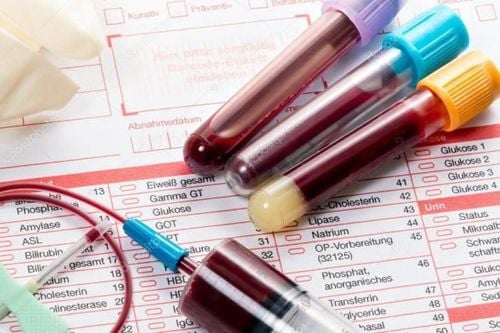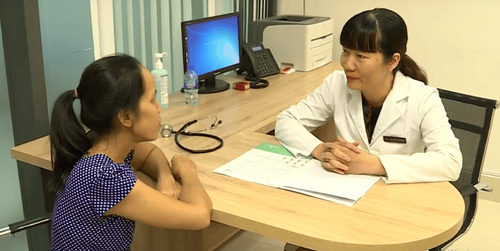This is an automatically translated article.
The article is professionally consulted by Master, Doctor Bui Tien Dat - Emergency Medicine - Cardiology - Emergency Resuscitation Department - Vinmec Hai Phong International General Hospital. The doctor has more than 12 years of experience in the field of emergency resuscitation - cardiology.Infective endocarditis is inflammation of the endocardium with ulcers and warts, which often (but not necessarily) occurs in a pre-existing or congenitally damaged endocardium.
1. Causes of infective endocarditis
Most cases of infective endocarditis are caused by streptococci. In addition, it is also caused by bacteria and other pathogens such as staphylococcus, pneumococcal encephalopathy, pneumococcus, and gonorrhea. Klebsiella pneumoniae, Salmonella, Brucella, Corynebacterium, Vibrio foetus, Actynomyces fungi, Candida albicans are also causes of infective endocarditis.These pathogenic bacteria enter through oral infections, skin infections, infections caused by abortion, some procedures that are not carefully disinfected such as blood transfusion, hemodialysis, and catheter placement. favorable conditions for bacteria to cause disease. Gastrointestinal infections, urinary tract infections due to urinary tract surgery, bladder stones are also the causes of streptococcal disease.
Besides, primary infective endocarditis is very rare, but often occurs in patients with pre-existing heart damage, usually valvular lesions, artificial heart valves, congenital heart defects, heart valves. damaged, mitral aortic valve, pulmonary stenosis, coarctation of the aorta...

>> See more: Learn about endocarditis - Article by Dr. Dao Thi Mai Lan - Vinmec Institute of Stem Cell and Gene Technology
2. Symptoms of infective endocarditis
Patients with infective endocarditis will have the following clinical symptoms:Persistent fever in people with underlying heart disease; Enlarged spleen, cupped fingernails, clubbing fingers; However, in practice, to be able to diagnose and treat early, one should consider subacute infective endocarditis before a heart patient has a fever that persists for more than 1 week for no reason and blood culture is given immediately. ; Purpura appears on the toes; Hemorrhagic debris, linear reddish-brown lesions, are seen in the nail bed of a patient with infective endocarditis caused by group B strep; Osler nodes are soft pustules that appear on the soft parts of the fingers of patients with staphylococcal endocarditis. Besides, the patient has signs of chills, night sweats, muscle and joint pain, persistent fatigue, shortness of breath, loss of appetite and weight loss.
Subclinical symptoms to recognize infective endocarditis include:
Blood cultures for pathogenic bacteria need to be performed several times before giving antibiotics, the patient needs to be cultured while feverish because at that time the possibility of infection positivity is most evident; Blood tests such as complete blood count show a slight decrease in the number of red blood cells, a moderate increase in the number of white blood cells, especially neutrophils; increased erythrocyte sedimentation rate; Urinalysis by other than proteinuria, in about 70-80% of cases with microscopic hematuria, is determined through the Addis residue test; Echocardiography clearly sees wart lesions to diagnose and determine disease status; Transesophageal ultrasound allows specific visualization of heart valves, checking for signs of infection; ECG if your doctor thinks infective endocarditis may be causing an irregular heartbeat; Computed tomography or electrocardiogram if the doctor diagnoses that the infection has spread to other organs.

3. Treatment of infective endocarditis
Treatments used for infective endocarditis include: antibiotic therapy, consideration of anticoagulation, surgical intervention, and effective prevention.Antibiotic therapy is applied in the diagnosis of:
Infective endocarditis caused by penicillin-sensitive streptococci; Infective endocarditis due to relatively penicillin-resistant streptococci; Infective endocarditis due to staphylococci on natural valves; Infective endocarditis due to staphylococci on prosthetic valve; Infective endocarditis due to enteric bacilli; Infective endocarditis blood culture negative; Empiric antibiotics or no bacterial culture – natural valve; Empiric antibiotics or no bacterial culture – prosthetic valve; Antibiotic injection for outpatients. The patient's fever is gone after 3-5 days of appropriate treatment, except for cases of staphylococcus aureus infection with a duration of 5-7 days, right endocarditis and infectious pulmonary embolism will have a long fever. . At the same time, patients with a microbiological response need to have blood cultures again after 48-72 hours of treatment, combined with periodic examination for heart failure, embolism, and complications.
Indications for surgery for cases of infective endocardial mucosa on natural valves, artificial valves, approach to infective endocarditis with neurological complications. Prophylactic antibiotic treatment for high-risk subjects such as prosthetic valves, valve repair with artificial materials, patients who have had endocarditis, patients with congenital heart disease, certain types of congenital heart disease. purple, congenital heart lips are surgical intervention placed artificial materials for 6 months or for life if the pine remains. Prophylactic antibiotics are no longer recommended for other forms of congenital heart or valvular heart disease.
Patients may be prescribed anticoagulation in endocarditis.
4. Complications of infective endocarditis
Patients with infective endocarditis, if not actively and properly treated, are at risk of facing the following complications:Heart failure; Uncontrolled infection; System occlusion; Neurological complications; Other complications such as: infectious aneurysms, acute renal failure, rheumatoid complications, splenic abscess, myocarditis, pericarditis; Even death during surgery accounts for 5-15%, the 10-year survival rate accounts for 60-90%, and the 15-20 year survival rate accounts for 50%.

5. Methods to limit the progression of infective endocarditis
Patients with infective endocarditis can limit the progression of the disease in the following ways:Proper oral hygiene every day; Avoid causing skin infections, limit body piercing and tattooing; Ensure safety when performing diagnostic tests or surgical procedures in the hospital; Treat heart-related conditions promptly; Avoid the use of intravenous drugs; Control your diabetes by making the right lifestyle changes; Immediately address any medical problems that weaken the immune system including treatment for HIV infection ; Regularly re-examine and actively treat as prescribed by the doctor if diagnosed with endocarditis. To protect their heart health, customers can sign up for Cardiovascular Screening Package - Basic Cardiovascular Examination of Vinmec International General Hospital. The examination package helps to detect cardiovascular problems at the earliest through tests and modern imaging methods. The package is for all ages, genders and is especially essential for people with risk factors for cardiovascular disease.
Please dial HOTLINE for more information or register for an appointment HERE. Download MyVinmec app to make appointments faster and to manage your bookings easily.














